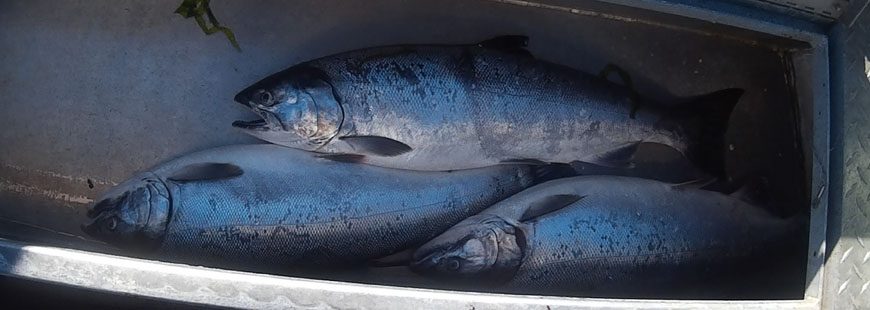Photo: three nice ocean-caught hatchery coho from 9/7/16. Hatchery coho don’t exhibit the same fitness level as wild coho, but they aren’t as susceptible to natural disasters that effect wild coho return rates either.
It’s not often that I stray from the salt in this blog, but Judge Daniel Murphy of Linn County has been hearing a lawsuit that could have profound impacts to how we manage state forest lands, the lands that grow not only trees, but also most of our runs of wild salmon in the Tillamook and Clatsop State forests.
It’s 2016, the science is in, and it appears the politics are too. Valuable lumber isn’t the only thing grown on state forest lands; wild salmon are a forest product too. For the first time in several years, Oregon’s freshwater anglers won’t have a chance to harvest wild coho in many of our coastal estuaries. Biologists are fearful that we’re on another downturn to wild coho, and as we’ve always stressed, conservation is priority one. It’s hard enough being a fishing guide, I’m glad I’m not trying to manage all of these stocks of fish.
Well, back to the lawsuit, it’s untenable to me that many of our policy-makers still don’t see the correlation between land and water; they’re inseparable. You’ve heard the quote, “For every action, there is an equal and opposite reaction.” Nothing could be further from the truth when it comes to land and water management.
The Oregon Department of Fish and Wildlife has studied coho salmon intensively. Through its findings, two of the greatest limiting factors of coho production is stream complexity and excessive water temperatures. Stream complexity is, of course, large woody debris, which is large enough to maintain itself in the watershed during the high water events that inundate the Tillamook watershed nearly every year. Due to the human caused fires of the Tillamook Burn, we have very little large woody debris to build stream complexity in the Tillamook State Forest. Tillamook is no mecca for coho and it may be a long while before it ever has that potential, but our lands are not managed for salmon production, they’re managed for timber production.
The Linn County lawsuit is wrong for so many reasons. Set aside the $1.4 billion hit to the state budget, and the millions of dollars in lawyer fees to be rendered… if the Linn County lawsuit is certified as a class action, it sets a dangerous precedent for the future management of these timber- and salmon-producing lands. State lawmakers will have little choice than to legislatively mandate harvest levels that favor timber and throw out all the other values these lands produce. What better way to keep coho on the Endangered Species List, right?
I have frequently referenced the Salmon 2100 Project, citing a plethora of salmon scientists that have come to the consensus that if we choose to manage our lands and waters on their current trajectory, wild salmon, as currently assessed, will be reduced to remnant levels by the year 2100. Look at what we’ve accomplished in the last 100 years. Columbia River salmon, once numbering fifteen to seventeen million, only come back at a fraction of that now; two million returning salmon to the Columbia is a good year, of those, only about 20% are of wild stock. On the Oregon Coast, we’re at about 7% of our historical abundance of wild fish and much of the prime habitat for these salmon is still relatively undeveloped.
It’s a bit embarrassing, at this point, to know what we know and still not take the appropriate action to slow the decline. We’re still miles away from recovery, but we have to term it that way, just to give ourselves hope. And the scariest factor? We don’t even know,what we don’t know just yet. Climate change, sea-level rise and population growth aren’t typically factored in to what the future holds for wild salmon. Does anyone ever really think Atlantic salmon will recover to any sustainable levels in the future? Most have given up hope for such a miracle.
Coho are our canary in the coal mine, an indicator of fresh and saltwater ecosystem health. Their life history requires them to over-summer in the watershed as well as over-winter. In 2014, the Tillamook district witnessed a huge return of wild coho back to the spawning grounds, resulting in a huge boom of coho fry hatching out of the gravel the following spring. Well, the summer of 2015, coupled with the five over-the-bank events of the winter of 2015/2016 resulted in record low recruitment of coho smolt (for outmigration) from coho fry in the watershed. A mere 0.01% survived to the smolting phase. That’s a record no species can sustain itself with, no matter how resilient.
The bottom line: we not only have to pay attention to how we manage our oceans. With the clear connection between the land and the sea, it’s high time we take an even bigger picture approach to fisheries management and forecast the challenges ahead, instead of reacting to the crises after they happen.


